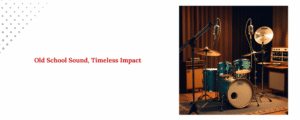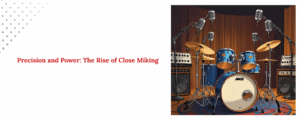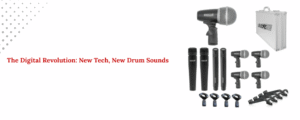Any type of music requires beat, force, and power and drums provide them all. However, the true sound of a drum kit has never been easy to achieve on records and during live shows. A major part of the problem is microphones. Mics have evolved so much over the years, especially with the large and primitive mics used then and now, with the special and precise ones. This article examines the innovative nature of drum microphone technology as a result of the current technology revolution.
The Beginning: The Old Days of Drum Miking
Microphones used in the early sound recording days were very basic, even by today’s standards. Ribbon and dynamic microphones were heavier and bigger and were popular during the 1930s to 1950s. They were mostly made for singing and brass instruments. Miking the drums was not so common, and either one microphone at a distance was used to catch the whole drum set.
The most common mic would be the dynamic mic. The sensitivity of these mics was not that high and they also failed to catch a wide range. They picked up what could not be done cold and drum miking methods changed, needing engineers to hear and split more.
The kind of recording tools was then more about how the room sounded and where the microphones were placed, rather than how the microphones were made. This sounded more live and the echo was natural and the drums were mixed a bit. Collectors and music fans still keep a want for this old sound, although it did not have the detail needed in the multi-track recording used now.
The Rise of Close Miking in the 1960s and 1970s
With the improvement of recording rooms, the possibility of recording drums improved. This is when close miking started in the 1960s and 1970s. It is at this point that individual drums were mic-ed as opposed to recording the entire kit using a single mic. This change required an increase in loudness and a faster reaction.
Moving mics, like the famous Shure SM57, became the best choice for snare drums. It became standard in its field because of its tough build, focused cardioid pickup pattern, and ability to handle loud sources. Engineers started using stronger dynamic mics for toms and kick drums, like the Sennheiser MD 421 that had a wider frequency range and could pick up the low-end punch and middle clarity that drums needed.
Condenser mics were also tested by people during this period because the range was wider and their accuracy was better. However, early condensers were otherwise very weak and costly, so few drums made use of them.
Close miking provided engineers with greater influence and control over the way that each drum would sound within the mix than ever before. Filtering and compressing were some common means to adjust the tone further. This technology totally transformed the sound of drums on records by making them sharp, tight, and clearer in sound as opposed to muffled and mixed.
Changes in Technology from the 1980s to the 1990s
Microphones improved with the entry of new materials and better technology in the 1980s. Producers began creating the mics specifically designed to work with drums. These mics were supplied with in-built shock-mount, superior diaphragms and greater SPL.
The greatest kick drum microphone of all time was the AKG D112, which was introduced into the market in the late seventies but became a major hit in the eighties. Due to its construction, it had the ability to capture deep, low-end power resonance of the kick in full and clear detail. The same reason resulted in this situation: Shure SM81 and AKG C451 SM mics were frequently used to capture the sounds of hi-hats and overheads due to their integrity and sensitivity.
As well, stereo overhead techniques such as XY and ORTF became more widespread during this period. These condenser mics not only captured the cymbals and the hi-hats but also the whole kit sound and room ambience, as well as the close-mic drumming.
In addition, by combining appropriate mics with the most appropriate mounts and wires, the drum mic kits created by such companies as Shure, 5Core, AKG, and Sennheiser assisted the engineers in the process of miking.
From the 2000s to Now: The Digital Age and New Technologies
Drum mics are superior to ever due to the invention of tech and designs. They offer:
- A greater sound spectrum to pick up bass beats and clean cymbals
- Great SPL level without distortion of loud hits
- Directional pickup to reduce bleed of other instruments
- Internal shock and Pop filters to have a clean sound
- Wireless alternatives of greater stage freedom
The Shure Beta 56A (tom mic), 5Core Drum Mic, the Sennheiser e604, and the Audix D6 (kick mic) are some of the most famous present drum mics. There is increased use of clip-ons, making drummers free to move around, and it is also less time-consuming to set up.
Conclusion
Technique and technology are combined in the form of drum mics. The oldest type of microphones was able to pick up sound, but it was distorted. Although they are old, the microphones are still powerful, precise and have a lot of uses. Microphones are also available in a wide variety that sound engineers and musicians can choose from nowadays. They are also able to bear strong drum sounds. There will never be a time when drum mics will not be useful, as recording technologies are becoming superior. They help in many ways in order to create music. Drum microphones are very old. They can acquire drum sounds with gentle and warm ribbon mics or hot and punchy dynamic ones. If you’re looking for a drum mic in bulk, then you can check this new platform for the best deals.




